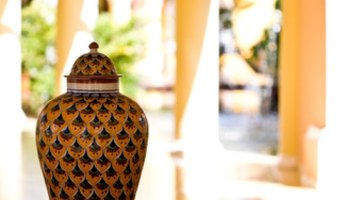How to Seal a Marble Table
Marble tables, counters, windowsills, thresholds, floors and walls are serious investments for most home owners. These materials are designed to last a lifetime when properly maintained.

The primary concern with some kinds of stone, including some kinds of marble, is the possibility of accidentally staining or etching the surface. One precaution that will slow the absorption of staining liquids is adding a sealer to the surface of the table. This should be done if your marble has a high absorption rate. Ask your furniture company or stone manufacturer about the absorption rate and porosity of your marble selection. No matter what type of marble you have, sealing the surface is the same process.
Things You Will Need
- Neutral pH stone cleanser
- Scrubber
- Distilled water
- Towel
- Marble sealer
Tip
Sealers do not add shine. Dullness is caused by etching or scratches. Etching is caused by citrus-laden soaps, sodas, and many types of food. Use coasters and clean up spills immediately to preserve the shine.
-
Scrub your marble table with a pH neutral stone cleanser product recommended for your type of stone. Use a scrubber to remove any stains or grease that may be hard for you to see.
-
Rinse your table with distilled water and dry the marble immediately. Distilled water does not have the minerals common in tap water, so it will not interact and leave mineral stains. Many spots on marble and stone are caused by hard water and a failure to dry the stone immediately.
-
Apply marble sealer to the table. Smaller bottles often have spray nozzles while larger cans have a pour spout. Spray or pour a quarter-sized amount of sealer on the marble and rub it in a circular pattern. Depending on the manufacturer, marble sealers contain silicon or acrylic/poly ingredients.
-
Wipe off the excess and repeat across the table. There should not be any moisture or liquid left on the marble when you are done. A sealed table should not need to be resealed for several years (depending on wear). Test the table by noting if water beads up on its surface. If water is absorbed, the table may need to be resealed.
The Drip Cap
- Marble tables, counters, windowsills, thresholds, floors and walls are serious investments for most home owners.
- The primary concern with some kinds of stone, including some kinds of marble, is the possibility of accidentally staining or etching the surface.
- This should be done if your marble has a high absorption rate.
- Apply marble sealer to the table.
- Spray or pour a quarter-sized amount of sealer on the marble and rub it in a circular pattern.
References
Writer Bio
F.R.R. Mallory has been published since 1996, writing books, short stories, articles and essays. She has worked as an architect, restored cars, designed clothing, renovated homes and makes crafts. She is a graduate of the University of California at Berkeley with bachelor's degrees in psychology and English. Her fiction short story "Black Ice" recently won a National Space Society contest.
Photo Credits
- Jupiterimages/Photos.com/Getty Images
- Jupiterimages/Photos.com/Getty Images
More Articles



